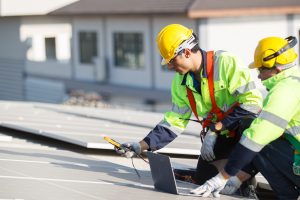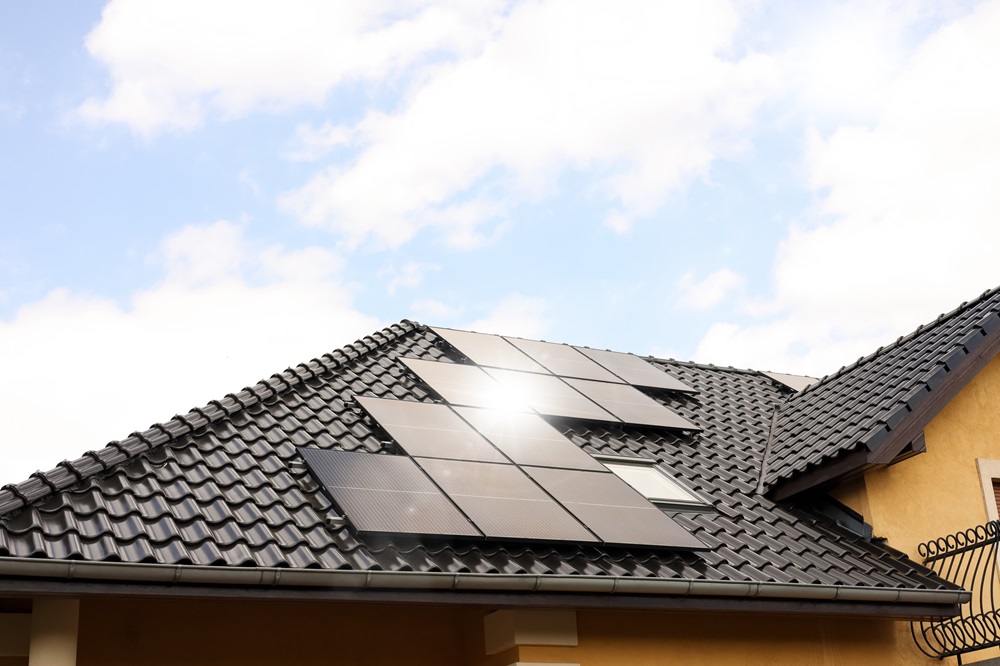Going solar at home is an exciting way to reduce your carbon footprint and save money on electricity bills. But what exactly does it take to capture the sun’s energy and convert it into usable power for your house? Let’s break down the main parts you’ll need.
The Heart of the System: Solar Panels
Solar panels are at the center of any residential solar solutions. These rectangular panels, typically installed on a sunny roof, are made up of many individual solar cells. The cells utilize a process called the photovoltaic effect to generate an electrical current when exposed to sunlight.
But how does it work? Each solar cell is made of semiconductor materials like silicon. When sunlight hits the cell, it knocks loose some electrons from the atoms in the silicon. Electrical conductors built into the cell then guide these freed electrons out as an electrical circuit, generating that all-important flow of electricity.
The size and efficiency of the panels determine how much electricity they can produce. More or higher-quality panels mean more potential power output when the sun’s rays are strong.
Inverters: Converting the Power
Now, you have solar panels generating direct current (DC) electricity from the sun’s rays. But your home’s electrical system and appliances run on alternating current (AC) power. That’s where inverters come in.
A solar inverter takes the DC electricity from the solar array and converts it into AC electricity that your lights, electronics, and other household devices can use. String inverters are the most common type for home solar. They’re a single box-shaped unit that the solar panels feed into.
Inverters also help monitor the solar system and can shut it down automatically if there’s a utility power outage to prevent feeding electricity back into local lines.
The Battery Bank (Optional)
What happens when the sun goes down or clouds roll in? Grid-tied solar systems simply draw electricity from the utility company when needed. But some homeowners opt for solar battery storage to capture excess solar power.
Batteries allow you to store energy from your solar panels during the day for use at night or during outages. The batteries are housed in a power bank connected to your solar system and home electric panel. When you need that stored solar power, an inverter converts the battery’s DC power into the AC electricity needed to run home devices.
Having a home battery backup provides more energy independence but also adds significant costs. It may be worth considering if you experience frequent power outages or live in an area with an unreliable grid.

Setting Up the Solar Array
How your solar panels, inverters, and batteries (if included) all get connected depends a lot on your particular system design and home’s configuration. But a few key components help enable that rooftop array:
- Racking – The actual mounting system that secures solar panels at the optimal angle and orientation toward the sun.
- Wiring – Specialized cables and connectors carry the DC electricity from each panel into the inverter system.
- Disconnects – Safety switches that can shut off the solar array from the inverters and home electric panel.
- Monitoring System – Digital software tracks real-time solar production and electricity usage.
Many installers now offer sleek racking systems integrated with wiring and disconnects to create a clean overall setup.
Putting it All Together
Once those main solar components are in place, they get wired into your home’s main electrical service panel. This is the integral connection point where your solar power either gets sent to meet your home’s electricity needs or gets routed back onto the utility grid.
For grid-tied solar homes without battery backup, any excess solar production beyond what the home requires simply flows in reverse onto the larger electrical grid. You may even earn credits from your utility company for this contributed solar power through net metering policies.
With batteries, any solar energy not used immediately in the home charges up the battery bank instead. Later, you can draw from those reserves during nights or outages before using utility power.
The Solar Monitoring System
While the basic anatomy of a solar system is easy to visualize, premium modern installations also include robust software monitoring. This digital monitoring not only tracks your solar system’s production in real time but can integrate with your home’s other smart devices.
By seeing exactly how much solar power is being generated compared to your home energy use, you can optimize efficiency and savings. Many systems can even control heating/cooling or adjust major appliances automatically based on solar output.
A smart monitoring app is accessible anywhere via smartphone. So you can always check in on your system’s performance, no matter if you’re home or not.
Going Solar Starts With the Right Plan
Even with the key solar components identified, actually designing and installing the ideal system for your home is a detailed process. The ideal number of solar panels and whether batteries are needed depends on factors like:
- Your home’s size and average energy usage
- The available roof space and angle toward the sun
- Local weather patterns affecting solar exposure
- Utility rates and net metering policies in your area
- Your budget for the upfront costs of solar
Working with experienced solar installers is crucial. They can evaluate your home’s solar potential through site surveys and specialized software. With their expertise, they can design an efficient, cost-effective system to meet your energy needs now and for decades to come.
Final Thoughts
So, while harnessing the sun’s power from rooftop solar panels may seem simple on the surface, making it a reality takes careful system planning and professional integration. By understanding the main components like the solar array, inverters, and potential batteries, you’re better prepared to make the switch to clean, renewable energy at home.

